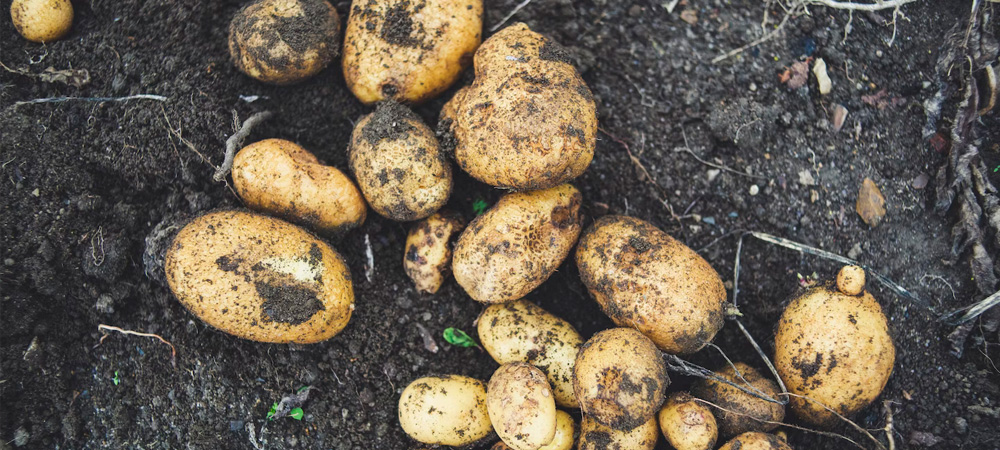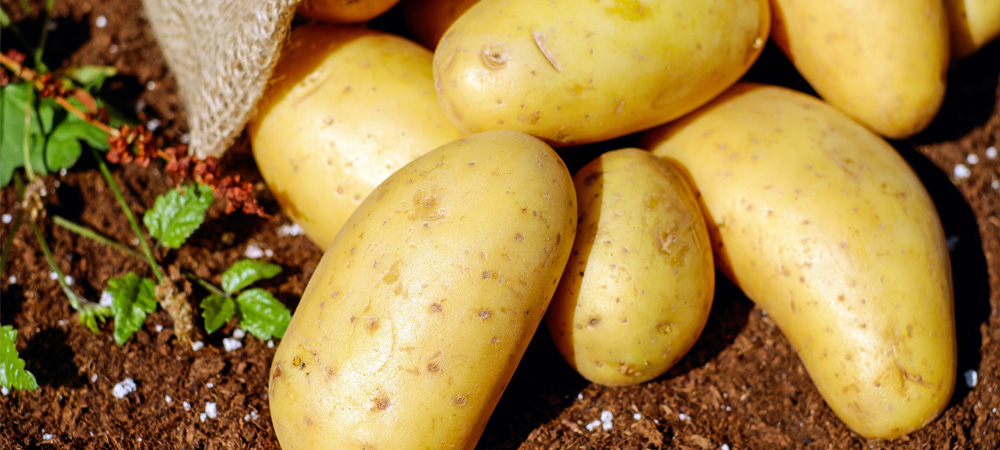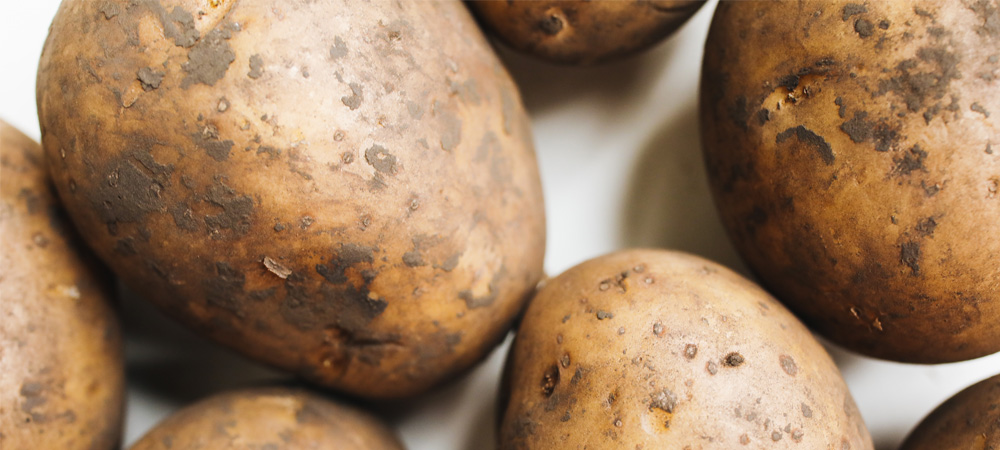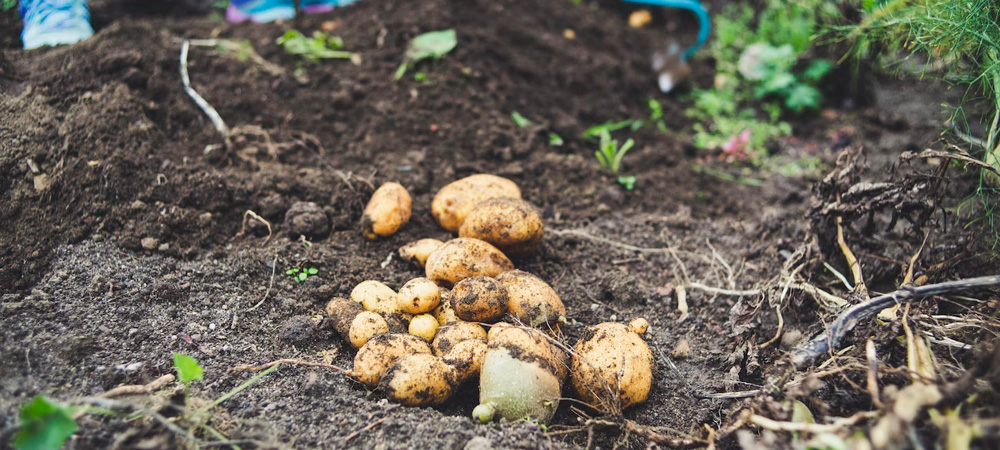How To Grow Potatoes

Are you interested in growing potatoes in a greenhouse? Then read on. Potatoes are renowned for their versatility and are fairly simple to grow.
Although they need quite a lot of space, nutrients, and care, you don’t need a massive garden to grow them due to the way they can be grown in bags and containers. It’s possible to grow up to ten potatoes from just one single potato plant.
Growing your potatoes
As potatoes are best as a cool-weather plant, as most of their growth occurs away from the summer months. Most potatoes are planted in early spring. However, you can plant them at the end of summer so they are ready for December harvesting if you want to create roast potatoes for Christmas dinner. However, it’s important to pick your varieties with care.
Need a new greenhouse? Shop the range of deals at South West Greenhouses
What are the main types of potatoes?
The three main kinds of potatoes are first early, second early and maincrop potatoes. These are separated by their planting and harvesting times.
First early potatoes
These are potatoes which you can plant first during the annual calendar. They can be planted out from the end of February and harvested from June. These potatoes are planted whilst their tubers are small and take around 10-12 weeks to fully mature.
As they have a fast growing cycle and small tubers, it means they’re great for growing in bags and containers. They should be spaced in rows 30cm apart, and there should be 60cm between rows.
Popular first early potato varieties
The main first early potato varieties include:
- Red Duke of York
- Second Early
- Arran Pilot
- Lady Christl
- Rocket
- Home Guard
- Orla
- Maris Bard
- Pentland Javelin
- Abbot
- Epicure
- Casablanca
- Purple Majesty
- Swift
Second early potatoes are classed as new potatoes or salad potatoes. They don’t store particularly well but do take a couple more weeks to mature than first early potatoes. You will need to wait around 14-16 weeks for these potatoes to mature. They can also be grown in containers and bags. You can plant them out in mid-March. They need to be spaced in rows 35cm apart, and there should be 75cm between rows.

It’s possible to grow some early potatoes for ‘second cropping’. This means you can plant them in August so they can be harvested at Christmas. However, frost protection will be needed. It’s best to grow them in bags in a greenhouse if you’re attempting second cropping. The potatoes won’t need to be chitted. This is because the ground will already be warm enough for quick growth.
When the tubers have reached the required size, cut the stems back, mound up earth to cover them and harvest them. Space them in rows 30cm apart, with 60cm between the rows.
Second early potato varieties include:
- Charlotte
- Maris Peer
- Anya
- British Queen
- Elfe
- Jazzy
- Kestrel
- Vivaldi
- Apache
- Athlete
- Jester
- Ratte
Maincrop
Maincrop potatoes include common baked potatoes and mash spuds. The benefits of these include how well they store. You can also eat them for several months after harvest. Their plants and tubers are much bigger than first and second early potatoes.
These potatoes also take longer to mature – you can expect to wait between 15 and 20 weeks. These potatoes can be planted out between March and mid-May. They are harvested from late August and need to be spaced in rows 45cm apart. There should be 75cm between the rows.
Varieties include:
- Adessa
- Maris Piper
- King Edward
- Desiree
- Cara
- Golden Wonder
- Picasso
- Pink Fire Apple
- Royal
- Rooster
- Salad Blue
- Sarpo Mira
- Setanta
- Vales Sovereign
- Valor
- Mozart
Sweet potatoes
It’s important to note that sweet potatoes are a little different to British potatoes. They are normally grown in warmer climates. This is not to say that they can’t be grown here – they simply require more attention.
What are the best cooking varieties?
If you’re making jacket or baked potatoes, Maris Piper, Maxine, Maris Peer, Nadine and King Edward may be your best options. King Edward, Kerr’s Pink, Arran Victory and Sarpo Axona are great for roast potatoes, whilst Maris Piper, King Edward, Arran Victor, Wilja, Vivaldi and Kestral are suitable for mash.
Nicola, Charlotte and Maris Peer are good for Christmas harvesting. First and Second Early Varieties are used as new and salad potatoes. If you wish to make sweet potatoes, go for Erato Orange, Makatea, Erato White, Tatakoto or Makatea.
The potato growth cycle
| Month | 1st Early Stage | 2nd Early Stage | Main Crop | 2nd Cropping |
|---|---|---|---|---|
| January | ||||
| February | ||||
| March | Chitting | Chitting | Chitting | |
| April | Planting | Planting | Planting | |
| May | Growth and Development | Growth and Development | Growth and Development | |
| June | Harvesting | Harvesting | Bulking | Planting |
| July | Harvesting | Harvesting | Ripening | Bulking |
| August | Harvesting | Harvesting | Harvesting | Ripening |
| September | Harvesting | Harvesting | ||
| October | Harvesting | |||
| November | Harvesting | |||
| December |
- Sprouting (1-2 weeks after planting) - This is when the seed potato starts to germinate and sends up shoots above the surface of the soil.
- Vegetative growth (2-3 months after planting) - At this stage, the plant grows stems and leaves whilst developing a tough root system
- Flowering (3-4 months) - The plant starts producing small white or purple flowers on long stems
- Tuber formation (4-5 months) - Underground tubers start forming and become bigger as the plant matures
- Senescence (5-6 months) - The plant leaves turn yellow and start dying off. This means the growing cycle is coming to an end.
- Harvesting (5-6 months) - The potatoes can be harvested after the plant has senesced.
Buying vs Producing Chit Potatoes
Seed potatoes can make it easy for you to grow your own potatoes. Seed potatoes aren’t seeds but tubers, just like other potatoes. Potatoes can produce seeds, but they are seldom used due to poor viability.
Seed potatoes have a shrivelled look and sprouting roots, which are often called eyes. If you leave potatoes in your cupboard too long without using them, they can start sprouting eyes.

You can plant potatoes from the ones you have left in your cupboard instead of buying seed potatoes. However, it can be difficult to produce viable plants from them. Some non-organic potatoes available in shops have been treated with chemicals in order to boost their shelf lives and limit sprouting.
These chemicals may cause damage to your soil and disease your plants. However, seed potatoes have been grown specifically with replanting in mind. They are also free from viruses.
Another good reason for purchasing seed potatoes is that you can plant them just a few weeks after purchasing them after you have chitted them. Nurturing your own can take months of your time.
Related growing guides:
- Chillies
- Tomatoes
- How to Plant Tomatoes in an Unheated Greenhouse
- How to String Tomatoes in a Greenhouse
- Grapes
- Cucumbers
- Peppers
- Lettuce
- Strawberries
- Melons
- Poinsettias
- Garlic
- Orchids
- Lavender
- Ranunculus
- Mushrooms
- Kiwi Fruit
- How To Pot and Plant Dahlias
- Courgettes
- Greenhouse Herbs
How do I chit potatoes?
Are you wondering what chitting means? Chitting means allowing tubers to sprout before planting. If potatoes are chitted well, they are likely to give you stronger plants once they are in the ground.
This process also makes it easier for you to identify potatoes which are struggling to develop so you can dispose of them prior to planting.
Around six weeks or so before you plant out, place seed potatoes either on a bright windowsill or in your greenhouse with the potato eyes pointing skyward. You should aim for between one and four sprouts per potato. Each of these sprouts should be around 2.5 to 3 inches long and purple or green in colour. If the sprouts are white, it’s likely they have light insufficiencies.
If you are interested in chitting potatoes, opt for ones which have been grown organically and are showing signs of sprouting. They should be approximately the size of a chicken egg.
Caring for Potato Plants
Try not to plant in the same place as last year as there could be diseases in the ground. Aim to plant in soil that’s slightly acidic and well-draining. Plant in a location which has full sun and make sure you loosen the soil prior to planting to a depth of approximately one foot.
Before you plant, make sure you mix well-rotted organic matter such as manure or compost into the soil. The potatoes should be planted with their eyes facing up. They can be grown in various locations including raised beds, bags and containers.
Think about which location is right for the variety you’re opting for as well as the space you have available to you. If you see any poisonous berries that look like tomatoes in the plant, get rid of them. Tubers should be kept covered and mound up as the plant grows. When potatoes turn green after being exposed to the sun, they turn green.

Ensure The Ground Is Prepped
Get your planting area prepared long before planting your potatoes. November and December are good months for this as the soil will have enough time to settle. Turning over the soil will loosen it. Remove any large stones or weeds and add a good amount of well-rotted organic matter.
Potato plants are root vegetables so they need a lot of energy so they can store it to grow large delicious tubers. Potatoes need many nutrients from the soil including nitrogen, potassium and phosphorus. Although potatoes are particularly at home in a rather acidic environment, they are able to tolerate most soil types.
They can leave your soul exhausted, so it’s best to avoid planting potatoes in the same place next time round. Rotating your crops ensures each area has time to recover.
Related blog posts:
- What Vegetables to Grow in a Greenhouse
- Propagator
- Beginners Guide to Allotments
- Best Way to Clear Weeds from an Allotment
- Grow Bags
- Greenhouse Gardening for Beginners
- What to Grow in a Greenhouse for Beginners
- What to Grow in a Small Greenhouse
- What to Grow in a Greenhouse in Summer
- What to Grow in a Greenhouse in Winter
- How to Grow Seeds in a Greenhouse
- When To Pinch Out Plants
Water your potatoes regularly
Potatoes need to be watered on a regular basis when they start flowing. This is when the tubers are growing beneath the ground. Be consistent with watering but avoid over-watering as this can rot your tubers. Free-draining soil is best.
Earthing Up
When your plants reach around 20cm tall, mount up earth around them to halfway up the stem. This process is known as “earthing up”. This needs to occur throughout the growing period. Drawing up soil around the stems encourages growth.
Make sure the growing tubers remain covered with a good amount of soil to stop them from turning green in direct sunlight once they begin to photosynthesise. If you’re growing in a bag or a container, only partially fill it when planting to leave enough space to add earth and mound up during growth.
Prune The Poisonous Seeds
Poisonous fruits and seeds grow above ground on potatoes. Remove these to protect children and pets. This will also stop the plant from going to seed prematurely. It’s essential to mound up the potatoes whilst they are in the ground and store them in a dark dry environment after harvesting to stop them from going green.
Harvesting potatoes
Make sure salad or baby new potatoes are harvested whilst the plant is still flowering. Cut the stems to the ground before unearthing the potatoes gently as and when they are required. You can leave the remaining potatoes in the ground until you need them – just ensure they are covered in earth so they don’t go green.
Leave maincrop potatoes until the leaves on the plant have begun to die back. You can then cut the plant down to the ground and carefully unearth the potatoes. Get rid of any potatoes which have begun to rot or look damaged.
If there are any you want to keep but don’t want to consume right now, you can leave these well covered in the earth. All potatoes left in the ground need to be well covered to prevent them from becoming green and poisonous.
Storing Harvested Potatoes
Some varieties of potato work well as storage potatoes due to their long dormancy period which means they are slow to sprout.
Examples of good storing potatoes include:
- Pink Fir Apple
- Kerr’s Pink
- Majestic
- Jazzy
- Maris Piper
- Sarpo Axona
You can store potatoes for several months before you eat them. Just remember to keep them in darkness so they don’t go green and get rid of any that look like they are rotting or damaged as the problems could spread to the rest of them.
Brush off excess soil rather than washing the potatoes as residual moisture can ruin them. Make sure they are kept in a dry, cool place that has good ventilation and is free of frost.
Common Issues
Potato blight
This is a fungal disease which can turn leaves yellow or brown and can cause tubers to rot. This can happen in excess humidity where conditions are too wet and warm. There is no hugely effective cure for potato blight.
You may be able to cut away affected leaves, but if you cut back too much you could compromise tuber growth. It may be best to dig up, harvest what you can and dispose of the rest. Do not compost the ones with potato blight.
Green potatoes
Potatoes go green when they are exposed to sunlight. If they are eaten, they can poison you. You can stop potatoes from going green by keeping them covered up by mounding up when they are in the earth and storing them in a dark place once they are harvested.
Common scab
This is a soilborne disease which people often don’t notice until harvest time. It can look like dark lesions on potato skins. You may be able to cut away affected areas to save the potatoes.
However, if plants are seriously affected, big problems can occur. The bacteria that causes common scab can stay in your soil for a long time and survive by consuming decaying plant matter. Make sure you remove as much as you can once harvested. Crop rotation can help you avoid future problems with common scab.
Potato rot
Wet conditions can cause rotting during and after lifting. To prevent potato rot, make sure potatoes are dry before you store them and don’t over-water them when they are maturing.
Conclusion
We hope you enjoyed our post on growing potatoes.
If you have any questions, leave them in the comments, or contact us at support@swgreenhouses.co.uk
 Author:
Author: